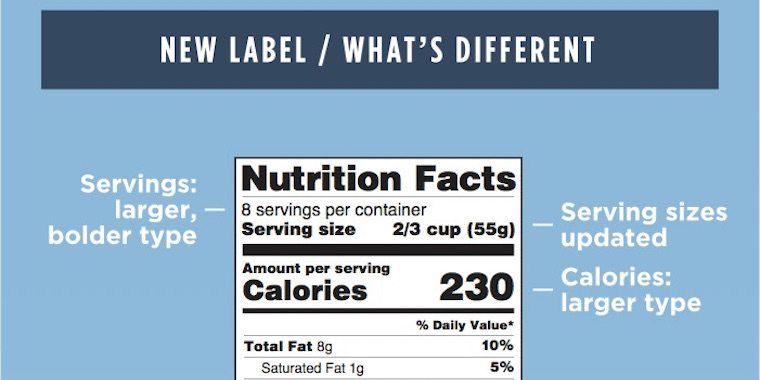The Food and Drug Administration recently announced that nutrition labels on food packages will be receiving a makeover.
The revised labels, which manufacturers will need to start using by July 26, 2018, will have the calories listed in a bigger and bolder type, include a new line for added sugars, and serving sizes will be updated to reflect a more realistic portion.
“We applaud the FDA and are thrilled that the new panel largely aligns with recommendations the Academy [of Nutrition and Dietetics] submitted to the FDA to help everyone make more informed and nutritious decisions when choosing foods to fit their lifestyles and needs,” registered dietitian nutritionist Lori Zanini told U.S. News & World Report. “The new panel better reflects serving sizes, nutrients and ingredients that people should focus on, and it updates current percent of daily values.”
To view a side-by-side comparison of the old and new labels, click here.
Two of the biggest changes are the serving sizes and the new focus on added sugars.
According to the FDA, serving sizes must now be based on the amounts of foods and beverages that people are actually eating, not what they should be eating. How much people eat and drink has changed since the previous serving size requirements were published in 1993. For example, the reference amount used to set a serving of ice cream was previously ½ cup but is changing to ⅔ cup. The reference amount used to set a serving of soda is changing from 8 ounces to 12 ounces.
“You will no longer need a microscope, a calculator, or a degree in nutrition to figure out whether the food you’re buying is actually good for our kids.” – First lady Michelle Obama
This is important, the FDA notes, because package size affects what people eat. Now, for packages that are between one and two servings, such as a 20-ounce soda or a 15-ounce can of soup, the calories and other nutrients will be required to be labeled as one serving because people typically consume those products it in one sitting.
The listing of added sugars, which will be shown in both grams and as percent daily value, is also key as scientific data shows that it is difficult to meet nutrient needs and remain within calorie limits if you consume more than 10 percent of your total daily calories from added sugar.
In addition to the FDA, the 2015-2020 Dietary Guidelines for Americans support reducing caloric intake from added sugars; and groups such as the American Heart Association, the American Academy of Pediatrics, the Institute of Medicine and the World Health Organization also recommend decreasing intake of added sugars.
The new labeling guidelines should make it easier to include a variety of nutritious foods from all the food groups into your diet. That is important as while you may currently be eating an appropriate amount of food, your body may not be getting the nutrients it needs to be healthy.
To learn more about how diet and exercise can benefit your health, contact AMP Fitness at 216-831-3674 or email us at
info@ampfitness.com.












